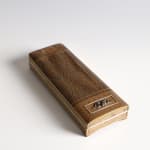Maki-e Artist
Koto-Shaped Writing Box, ca 1910
Maki-e gold lacquer on wood with silver rims and inlay
Size 1½ x 8½ x 3½ in. (4.1 x 21.9 x 8.6 cm)
T-2450
Further images
-
(View a larger image of thumbnail 1
)

-
(View a larger image of thumbnail 2
)

-
(View a larger image of thumbnail 3
)

-
(View a larger image of thumbnail 4
)

-
(View a larger image of thumbnail 5
)

-
(View a larger image of thumbnail 6
)

-
(View a larger image of thumbnail 7
)

-
(View a larger image of thumbnail 8
)

-
(View a larger image of thumbnail 9
)

-
(View a larger image of thumbnail 10
)

A lacquer suzuribako writing box in the form of a thirteen stringed koto. The top uses the mokume technique to simulate wood. The strings are done in takamaki-e, the short...
A lacquer suzuribako writing box in the form of a thirteen stringed koto.
The top uses the mokume technique to simulate wood. The strings are done in takamaki-e, the short sides in okibirame. The short sides are inlaid with gold, silver and coral cherry blossoms on a fundame background. The string insertion is a silver inlay in the shape of a dragon. The inside edges are lined in silver.
This was most likely custom made for a wealthy merchant and placed in the entrance where the guests would sign in
Provenance: Elaine Ehrenkranz Collection
Published: B.T. Okada, A Sprinkling of Gold: The Lacquer Box Collection of Elaine Ehrenkranz, The Newark Museum, 1983, exh. cat., p. 119
The top uses the mokume technique to simulate wood. The strings are done in takamaki-e, the short sides in okibirame. The short sides are inlaid with gold, silver and coral cherry blossoms on a fundame background. The string insertion is a silver inlay in the shape of a dragon. The inside edges are lined in silver.
This was most likely custom made for a wealthy merchant and placed in the entrance where the guests would sign in
Provenance: Elaine Ehrenkranz Collection
Published: B.T. Okada, A Sprinkling of Gold: The Lacquer Box Collection of Elaine Ehrenkranz, The Newark Museum, 1983, exh. cat., p. 119









